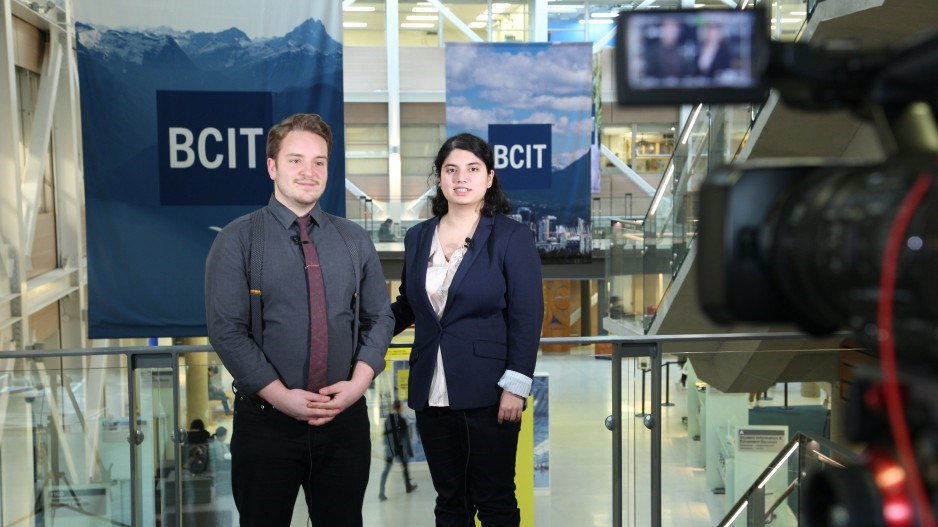It’s happening again: the big bang.
But this newest massive explosion has nothing to do with the beginnings of the universe or a group of nerds on a TV sitcom. The current big bang involves the ever-expanding, ever-more-complex digital media realm that’s transforming technology, information and the labour force – but never fear, says Edward Fajardo, head of the British Columbia Institute of Technology (BCIT) New Media Design and Web Development program in Digital Arts at the School of Business. A “big constellation” of multi-talented students from that one-year program are ready for the challenges of this exciting, admittedly sometimes alarming new age.
Both Fajardo and Julia Foy, an instructor with BCIT Business Broadcast and Online Journalism – part of the Broadcast and Media Communications program – stress the intensive, across-all-platforms skills students in their programs receive. These skills are unique to BCIT and coveted by industry. The fact is, in the new tech-savvy workforce the traditional silo structure of one person, one job skill has faded out along with the clacking of typewriter keys.
“Social media has changed the goalposts,” says Foy. “You have to be able to respond by getting creative content pushed out to consumers as soon as possible. You have to be able to work in TV, radio and online.”
Being single-career-ready isn’t enough, agrees Fajardo. “The New Media program is designed to produce graduates who can work in a large array of industries that require web design, graphic design, user interface design and user experience, app solutions, web marketing, social media integration and media communications. BCIT’s pragmatic approach to education is preparing its students for the future right here, right now.”
To succeed in this dynamic, evolving field, you have to do more than accept the new world of continual change and learning. You have to thrive on it. Students get well prepared – not to mention stoked – for this new world in both BCIT Business programs, where faculty meet regularly with industry leaders to ensure courses meet the latest job skills and requirements. Of his grads, 96% of whom are hired right away, Fajardo says, “They charge out of the gate wanting to keep increasing their operational value and creating new opportunities for themselves and the industry sectors they serve.”
In contrast to the clock-punchers of the past, New Media and Broadcast specialists enjoy using their creative and tech skills both during and outside office hours. New Media grad Madeline Adams, now a graphic designer and photo editor with the Knowledge Network, is setting up an online magazine in her free time with friends. Work isn’t just a profession; it’s a passion, Adams explains. “You work hard in the program, both independently and as part of a team. You come out with a great portfolio – and you end up developing your own brand.”
Adams credits the all-platform approach for her diversity of creative and tech skills. “The more tools you have in your tool box, the more appealing you are to employers and to new opportunities. Before, for example, you might have only been focused on video. You would have had to hand off the titles for your video to a graphic designer. Now, having online, print, video, audio, motion graphics and much more, you speak everyone’s language. This makes it easier to communicate with teams, instead of being segmented off and single-project-based. It broadens your mind and your horizons.”
Similarly, Broadcast grads are “getting poached and approached by all kinds of organizations as well as by the traditional media ones,” says Foy. “Employers recognize the value of having people who can take massive amounts of info and distil it into a conversational tone; who can find focus, tell stories, shoot own their video and collect audio and produce professional-grade presentations. This is where the industry is going. At the end of the day, it’s about content creation. Any organization that wants creative content and active, strong storytelling wants our grads.”
With his advice for students, Broadcast grad Simon Little, now a digital reporter at CKNW, shows his journalistic skill at getting to the point: “Try to be a Swiss Army knife. Know how to do it all. Learn to be a video journalist, to do radio and digital, to be your own one-person crew. All news organizations, whether print, TV or radio, have online departments and other jobs, too. You don’t know what positions are going to open up, so be prepared for them.
“You’ll get the skills to do that at BCIT,” Little promises. “It’s hard work but it’s also fun and creative.”




